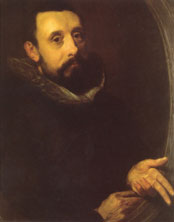

Composer. The elder son of Peter
Swybbertszdon and Elske Sweeling, he adopted his mother's
family name. The assertion that he studied in Venice with
Zarlino is not supported by surviving evidence. His only known
teachers besides his father were Jacob Buyck, pastor at the
Oude Kerk, Amsterdam, and Jan Willemszoon Lossy, a countertenor
and shawm player at Haarlem, who taught him not organ but composition.  By 1580, and possibly as early as
1577, he was organist at the Oude Kerk; his duties there were
probably to provide an hour of music twice daily in the church.
He became famous for his brilliant improvisations at the organ
and harpsichord. From this time onward he left Amsterdam only
to inspect new organs and advise on repairs and restorations.
As a teacher Sweelinck was influential and sought after, and
his pupils were among the most highly regarded musicians of the
time; they included Andreas Düben, Peter Hasse,
Samuel
and Gottfried Scheidt, Paulus Siefert, Ulrich Cernitz, Jacob
Praetorius, and
Heinrich
Scheidemann
, founders of the so-called north German organ school of the
17th century. Sweelinck's 254 vocal works, which were all
printed, include thirty-three chansons, nineteen madrigals,
thirty-nine motets (
Cantiones sacrae,
1619), and 153 Psalm settings. His 70 keyboard works consist
mainly of fantasias (
Fantasia chromatica
), echo fantasias, toccatas, and variations.
By 1580, and possibly as early as
1577, he was organist at the Oude Kerk; his duties there were
probably to provide an hour of music twice daily in the church.
He became famous for his brilliant improvisations at the organ
and harpsichord. From this time onward he left Amsterdam only
to inspect new organs and advise on repairs and restorations.
As a teacher Sweelinck was influential and sought after, and
his pupils were among the most highly regarded musicians of the
time; they included Andreas Düben, Peter Hasse,
Samuel
and Gottfried Scheidt, Paulus Siefert, Ulrich Cernitz, Jacob
Praetorius, and
Heinrich
Scheidemann
, founders of the so-called north German organ school of the
17th century. Sweelinck's 254 vocal works, which were all
printed, include thirty-three chansons, nineteen madrigals,
thirty-nine motets (
Cantiones sacrae,
1619), and 153 Psalm settings. His 70 keyboard works consist
mainly of fantasias (
Fantasia chromatica
), echo fantasias, toccatas, and variations.
Curtis, Alan. Sweelincks's Keyboard Music. London: Oxford University Press, 1969.
Dirksen, Pieter. The Keyboard Music of Jan Pieterszoon Sweelinck, Its Style, Significance, and Influence. USA: Music Library Association, 1998.
Noske, Frits. Sweelinck. London: Oxford University Press, 1988.
Richolson, Edna Sollitt. Dufay to Sweelinck. New York: Ives Washburn Publishers, 1933.